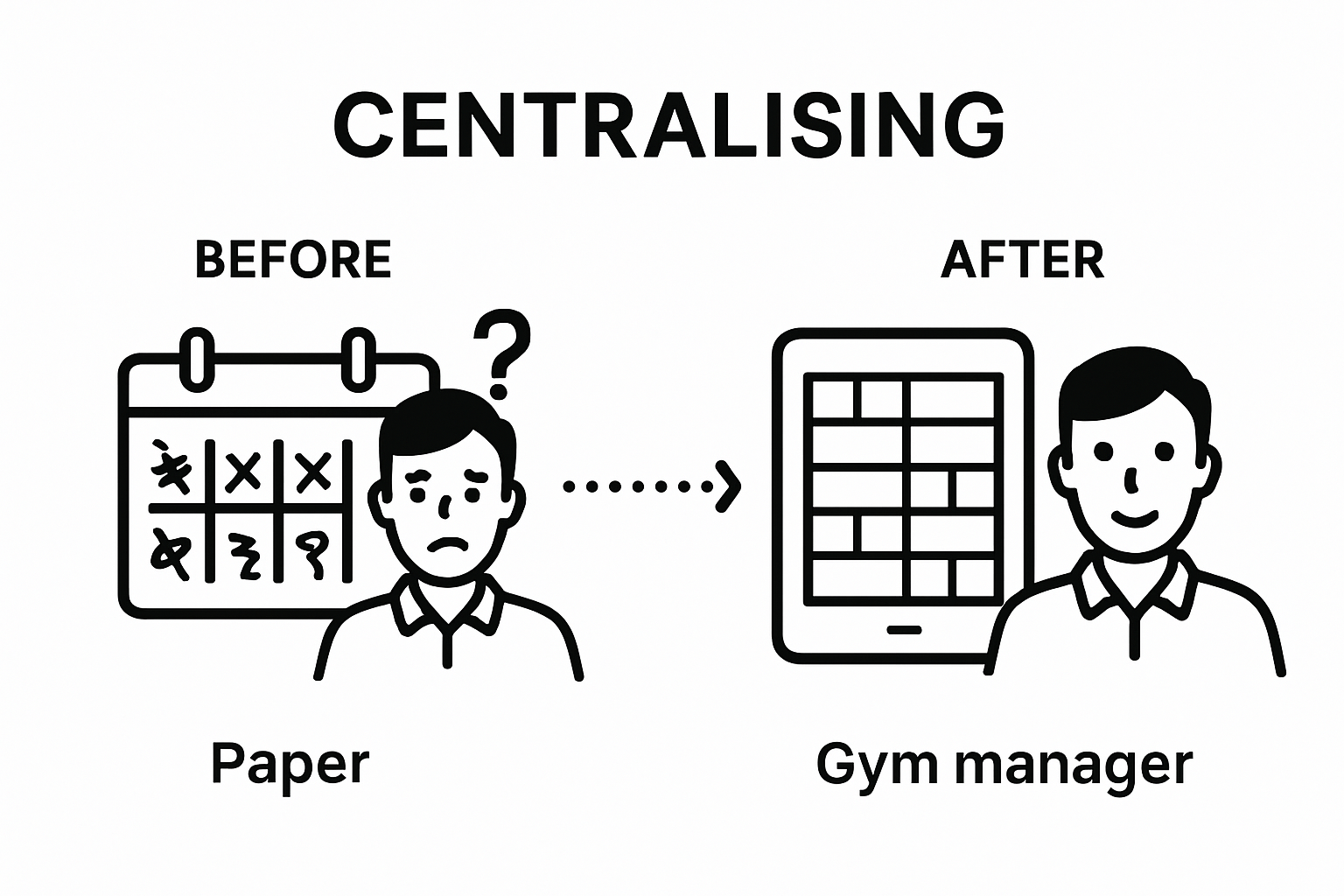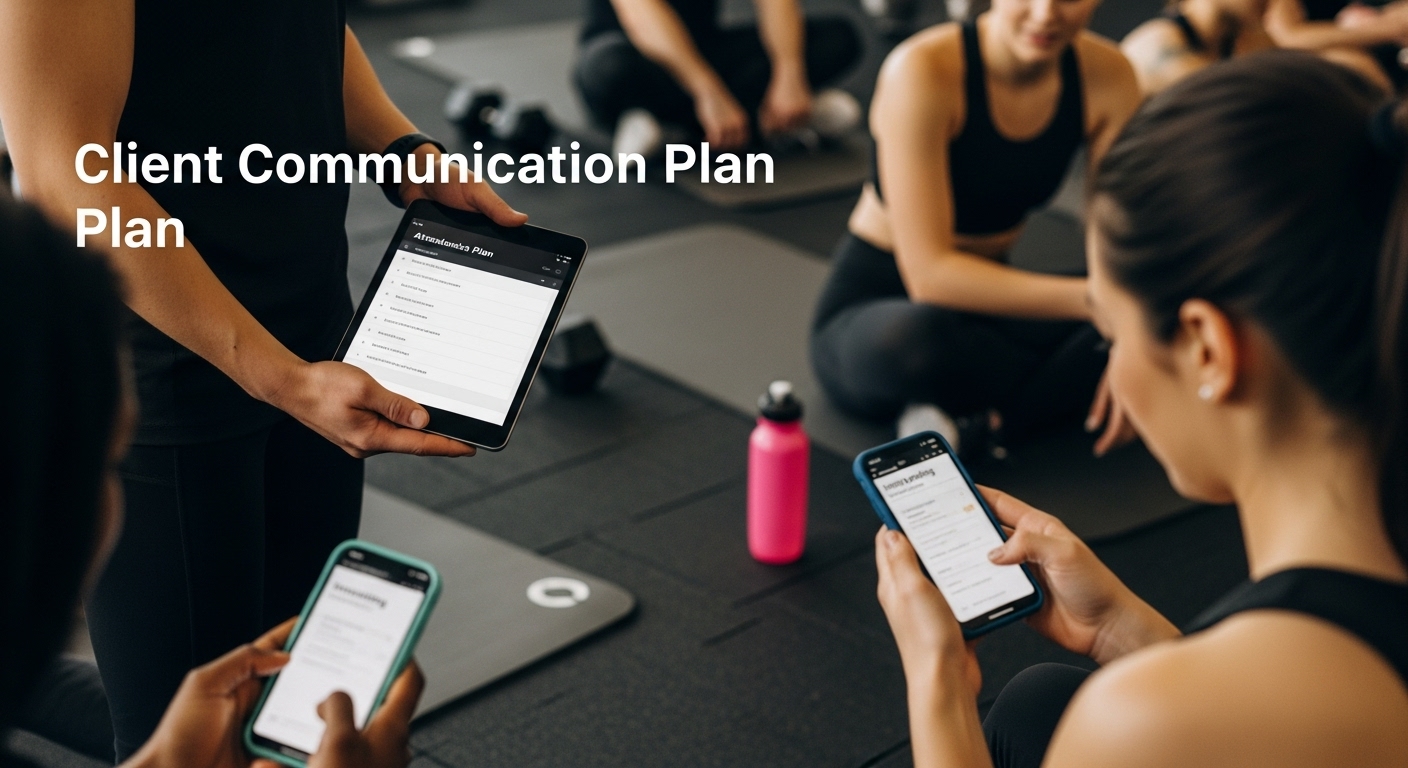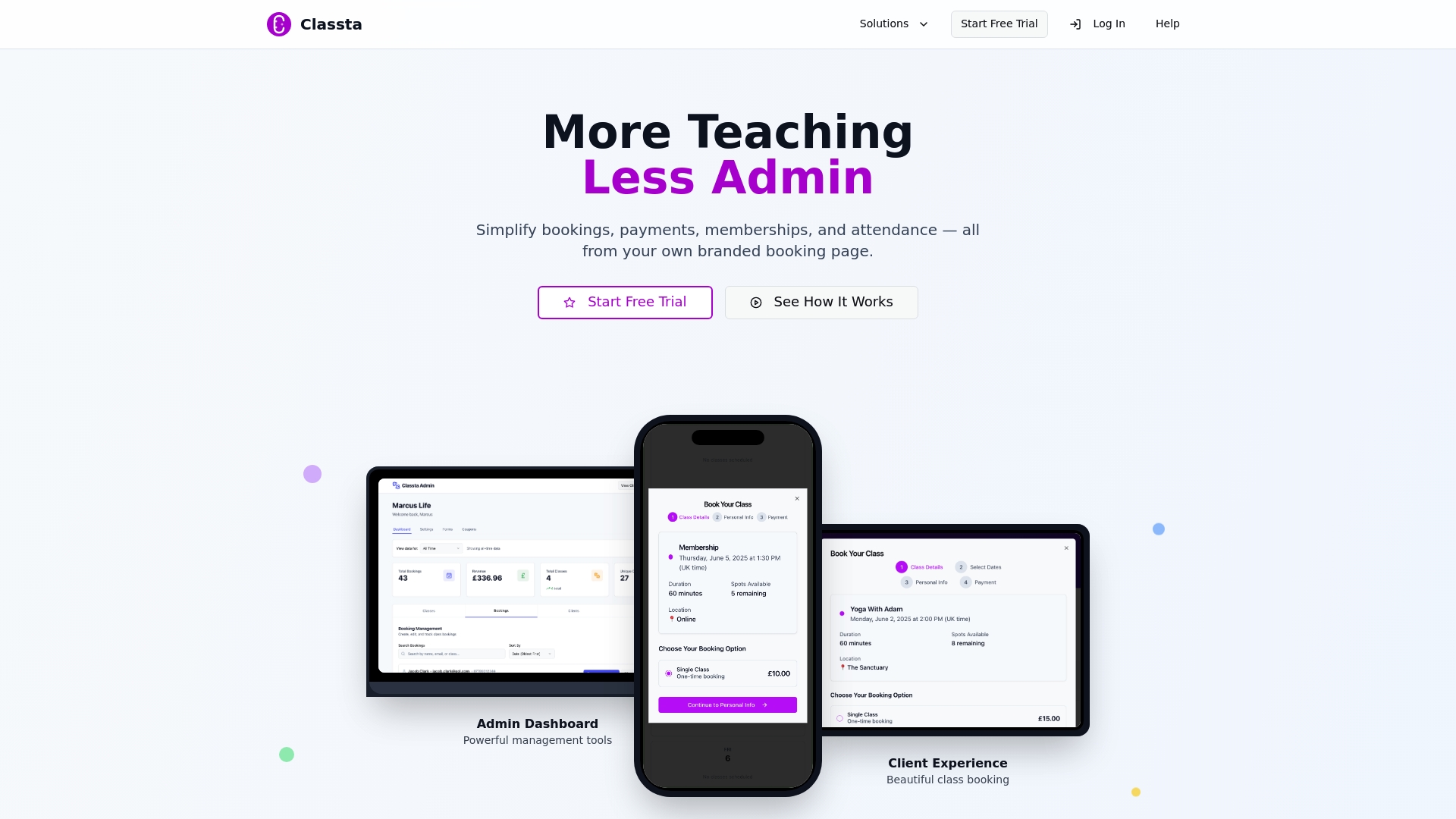Managing fitness class schedules can feel like an endless juggling act. Every missed booking or double class eats into profits and patience. Yet despite so many gyms relying on paper sign-in sheets or scattered spreadsheets, over 60 percent of instructors still lose hours each week to manual scheduling tasks. Digital tools do not just save time or avoid mistakes. They can actually transform the way your clients experience every class.
Table of Contents
- Step 1: Assess Your Current Scheduling Practices
- Step 2: Identify Key Scheduling Tools And Technologies
- Step 3: Create A Centralised Scheduling System
- Step 4: Set Up A Client Communication Plan
- Step 5: Review And Adjust Your Schedule Regularly
- Step 6: Monitor Performance And Client Feedback
Quick Summary
| Key Point | Explanation |
|---|---|
| 1. Assess current scheduling practices | Examine your existing systems to identify inefficiencies and areas for improvement. Conduct audits of all booking processes and client experiences. |
| 2. Identify suitable scheduling tools | Explore technology solutions that streamline scheduling, including automated booking and mobile accessibility. Choose tools that fit your needs and budget. |
| 3. Establish a centralised scheduling system | Consolidate class schedules and client records into one platform to reduce complexity and enhance the user experience. |
| 4. Develop a client communication plan | Create a strategy to keep clients informed and engaged with timely updates and personalised messages, fostering better relationships. |
| 5. Regularly review and adjust schedules | Conduct periodic assessments of scheduling effectiveness, adjusting classes and times based on attendance trends and client feedback for improvement. |
Step 1: Assess Your Current Scheduling Practices
Effective fitness class management begins with a comprehensive evaluation of your current scheduling infrastructure. This critical first step allows you to identify inefficiencies, bottlenecks, and opportunities for improvement in how you manage client bookings and class organisation.
Start by conducting a thorough audit of your existing scheduling system. Gather all current documentation: paper records, digital calendars, spreadsheets, and any booking platforms you currently use. Examine these materials with a critical eye, looking for patterns of complexity or friction that might frustrate your clients or consume unnecessary administrative time.
Understanding Your Current Workflow
Make a detailed map of your current booking process from initial client contact through class confirmation. Pay attention to how clients currently book classes, the steps involved in confirming attendance, and how you manage waitlists or cancellations. According to research from the National Academies of Sciences, Engineering, and Medicine, a formal assessment of supply and demand is crucial for creating an efficient scheduling system.
Track metrics that reveal your current system’s performance. Key indicators include:
- Average time spent on manual booking processes
- Number of scheduling errors or double bookings
- Client satisfaction rates related to booking experience
- Percentage of classes operating at full or near-full capacity
Identify the most time-consuming aspects of your current scheduling approach. Are you manually sending confirmation emails? Tracking attendance through paper sign-in sheets? Updating class rosters through multiple disconnected systems? These are clear signals that your scheduling practices need modernisation.
Finally, solicit feedback directly from your clients and instructors. Their perspectives can uncover hidden inefficiencies and provide insights into potential improvements. A system that feels seamless to you might be frustratingly complex for your clients or teaching staff.
By meticulously documenting your current scheduling practices, you create a baseline from which meaningful improvements can emerge. This foundational step prepares you for implementing more streamlined, technology-enabled solutions that will transform how you manage fitness classes.
Step 2: Identify Key Scheduling Tools and Technologies
Transitioning from manual scheduling to technology-driven solutions represents a pivotal moment in fitness class management. This step focuses on discovering and selecting digital tools that will transform your administrative workflow, making scheduling more efficient and client-friendly.
Begin by exploring comprehensive scheduling platforms specifically designed for fitness professionals. Look for solutions that offer integrated features beyond basic calendar management. Key functionalities to prioritise include automated booking confirmations, client communication tools, payment processing, and attendance tracking.
Evaluating Scheduling Technology
As research from the 9th International Conference on Computer and Communications Management suggests, mobile applications can significantly enhance program scheduling and member experience. When investigating potential tools, consider platforms that provide mobile accessibility, allowing clients to book classes and instructors to manage schedules from smartphones or tablets.
Create a comprehensive evaluation matrix for potential scheduling technologies. Essential criteria should encompass:
- Ease of user interface and navigation
- Integration capabilities with existing systems
- Cost-effectiveness and pricing structures
- Customer support and training resources
- Scalability for future business growth
Pay close attention to cloud-based solutions that offer real-time synchronisation across multiple devices. These platforms eliminate the risk of double bookings and provide instant updates to both instructors and clients. Look for tools that generate automatic notifications for class changes, cancellations, or waitlist movements.
Investigate platforms offering additional features like client management databases, financial reporting, and marketing integration. Some advanced systems provide analytics that help you understand class popularity, peak booking times, and client retention metrics.
Remember that the most expensive or feature-rich solution is not always the best fit. Select a tool that aligns with your specific business needs, technical comfort level, and budget constraints. Many platforms offer free trials, enabling you to test functionality before making a financial commitment.
The following table summarises the essential criteria to consider when evaluating scheduling technologies for your fitness business.
| Criteria | Description | Importance |
|---|---|---|
| Ease of use | User-friendly interface and navigation for staff and clients | High |
| Integration | Ability to link with existing systems and tools | High |
| Cost-effectiveness | Affordable pricing structure in line with budget | Medium |
| Customer support | Quality of support and availability of training resources | Medium |
| Scalability | Capability to grow with your business needs | High |
By methodically assessing and selecting the right scheduling technology, you create a robust foundation for streamlined fitness class management that will save time, reduce administrative burden, and enhance overall client experience.
Step 3: Create a Centralised Scheduling System
Establishing a centralised scheduling system transforms your fitness class management from fragmented processes to a streamlined, efficient operation. This critical step consolidates all scheduling activities into a single, integrated platform that reduces administrative complexity and enhances client experience.

Consolidation is the key principle in creating an effective centralised scheduling system. Begin by migrating all existing booking information, client records, and class schedules into your chosen digital platform. This means transferring data from spreadsheets, paper records, and disparate digital tools into one comprehensive system.
Building Your Unified Scheduling Infrastructure
According to research in the Journal of Medical Systems, centralised scheduling systems significantly improve resource allocation and reduce operational conflicts. When implementing your system, prioritise platforms that offer seamless data integration and real-time synchronisation across all devices and user types.
Design your centralised system with clear user roles and permissions. Determine access levels for different stakeholders:
- Administrators with full system management capabilities
- Instructors who can view and modify class schedules
- Clients with booking and cancellation permissions
- Support staff with limited administrative access
Ensure your chosen platform supports multi-class and multi-instructor management. The system should allow you to create recurring class schedules, manage instructor availability, and handle complex booking scenarios like waitlists or package-based registrations.
Implement robust data validation and conflict prevention mechanisms. Your centralised system should automatically prevent double bookings, alert instructors to scheduling conflicts, and provide clear visual representations of class availability and capacity.
Consider the client experience when designing your system. The booking process should be intuitive, with clear class descriptions, instructor information, and straightforward payment options. Smooth user experience drives client retention and reduces administrative inquiries.
Regularly review and refine your centralised scheduling system. Set aside time monthly to assess system performance, identify potential improvements, and ensure all team members are comfortable with the platform. Continuous adaptation ensures your scheduling infrastructure remains efficient and responsive to evolving business needs.
Step 4: Set Up a Client Communication Plan
A robust client communication plan transforms scheduling from a transactional process into an engaging, relationship-building experience. This critical step ensures your clients remain informed, connected, and motivated throughout their fitness journey.
Effective communication is the cornerstone of client retention. Your plan should create multiple touchpoints that keep clients informed about class schedules, changes, and upcoming opportunities while maintaining a personal and professional connection.
Designing Your Communication Strategy
According to Stanford University’s communication guidelines, developing a comprehensive communication strategy requires careful planning and targeted approach. Begin by segmenting your client base according to their fitness interests, class frequencies, and engagement levels.
Implement an automated communication system that delivers timely and relevant information across multiple channels. Consider integrating:
- Automated email confirmations for class bookings
- SMS reminders before scheduled classes
- Weekly or monthly newsletters highlighting class updates
- Personalised performance tracking communications
Customise your communication frequency and tone to match different client segments. New clients might require more detailed information and encouragement, while experienced members may prefer concise, direct updates. Personalisation is key to maintaining client engagement.
Utilise your scheduling platform’s communication tools to send targeted messages. This might include early-bird class notifications, special workshop announcements, or personalised fitness progress reports. The goal is to create a communication ecosystem that feels both professional and individually tailored.
Develop a clear protocol for handling communication exceptions. Establish guidelines for last-minute class cancellations, instructor changes, or emergency notifications. Your communication plan should include rapid dissemination methods that keep clients informed and minimise disruption to their fitness routines.
Regularly solicit feedback about your communication approach. Include short surveys after communications or classes to understand how clients perceive the information they receive. This continuous improvement mindset ensures your communication strategy remains dynamic and client-focused.

By methodically developing a comprehensive communication plan, you transform scheduling from a mere administrative task into a powerful client engagement tool that supports long-term fitness success.
Step 5: Review and Adjust Your Schedule Regularly
Schedule management is not a one-time task but an ongoing process of refinement and adaptation. Regular review and strategic adjustment ensure your fitness class scheduling remains responsive to client needs, instructor availability, and evolving business dynamics.
Consistent evaluation is the heartbeat of effective scheduling. Establish a structured approach to reviewing your scheduling system, creating a rhythm of assessment that prevents stagnation and promotes continuous improvement.
Implementing a Systematic Review Process
According to research exploring scheduling models, periodic schedule reviews are crucial for optimizing resource utilization and meeting participant needs. Set a consistent schedule for comprehensive system reviews, preferably monthly or quarterly, depending on your business size and complexity.
Develop a comprehensive review checklist that encompasses multiple performance dimensions:
- Class attendance and cancellation rates
- Client feedback and satisfaction metrics
- Instructor availability and performance
- Revenue generated per class time slot
- Waitlist and booking trend analysis
Utilize your digital scheduling platform’s analytics tools to generate detailed reports. Look for patterns in booking behaviours, identifying peak times, underutilised class slots, and potential opportunities for schedule optimization. Data-driven insights will guide your strategic adjustments.
Engage directly with clients and instructors during these review processes. Conduct short surveys, host feedback sessions, or create informal communication channels that allow stakeholders to share insights about scheduling preferences and challenges.
Be prepared to make dynamic adjustments. This might involve shifting class times, introducing new class formats, redistributing instructor assignments, or modifying pricing structures based on your analytical findings. Flexibility is key to maintaining a responsive and attractive fitness class schedule.
Implement a trial period for significant scheduling changes. Instead of making sweeping modifications, introduce adjustments incrementally and monitor their impact. This approach allows you to validate changes without disrupting your entire operational ecosystem.
Remember that schedule review is not just about numbers but about creating an exceptional client experience. Each adjustment should aim to enhance convenience, accessibility, and enjoyment for your fitness community.
This table offers an overview of the main checklist items for reviewing and adjusting your fitness class schedule.
| Review Item | Purpose | Review Frequency |
|---|---|---|
| Class attendance rates | Assess popularity and demand for classes | Monthly/Quarterly |
| Client feedback | Identify satisfaction and areas for improvement | Monthly/Quarterly |
| Instructor availability | Ensure sufficient staffing for all scheduled classes | Monthly/Quarterly |
| Revenue per time slot | Measure financial performance by time and class | Monthly/Quarterly |
| Waitlist and booking trends | Recognise demand patterns and peak periods | Monthly/Quarterly |
Step 6: Monitor Performance and Client Feedback
Performance monitoring and client feedback collection transform raw data into actionable insights that drive continuous improvement in your fitness class management. This crucial step helps you understand the effectiveness of your scheduling strategies and identifies opportunities for enhancement.
Systematic feedback collection is the foundation of responsive business management. Develop a comprehensive approach that captures both quantitative metrics and qualitative client experiences across multiple channels.
Creating a Robust Feedback Ecosystem
According to research in the International Journal of Environmental Research and Public Health, digital management systems provide powerful tools for tracking fitness program performance and gathering real-time client insights.
Implement a multi-layered feedback mechanism that captures information through various touchpoints:
- Post-class digital surveys
- Monthly performance reviews
- Direct email feedback requests
- In-app rating systems
- Periodic face-to-face or virtual feedback sessions
Utilise your scheduling platform’s analytics tools to generate detailed performance reports. Track critical metrics such as class attendance rates, client retention, booking conversion rates, and instructor performance indicators. Look beyond surface-level numbers to understand the underlying trends and patterns.
Develop a standardised process for reviewing and acting on feedback. Create a scoring system that helps prioritise client suggestions and operational improvements. Not all feedback will require immediate action, but each piece of input should be carefully considered and documented.
Encourage a culture of transparency by sharing how client feedback translates into tangible improvements. When clients see their suggestions implemented, they feel valued and become more invested in your fitness community.
Establish a regular cadence for comprehensive performance reviews. Monthly or quarterly deep-dive sessions can help you identify long-term trends, potential issues, and opportunities for innovation. These reviews should involve key team members, including instructors and administrative staff.
Remember that monitoring performance is not about criticism but continuous improvement. Approach feedback with an open mind, viewing each comment as an opportunity to refine your services and create a more exceptional client experience.
Take the Stress Out of Fitness Class Scheduling
Is manual scheduling, tracking cancellations, and following up with client reminders taking up valuable time? If you find that inefficiencies, booking errors, and frustrating admin tasks are holding your fitness business back, you are not alone. Many instructors struggle with complicated processes that limit growth and make class management overwhelming. The article above highlighted the need for a centralised scheduling system, automated communications, and regular schedule reviews to unlock a seamless client experience and boost efficiency.

Imagine your entire booking and payments system running itself while you focus on teaching and building your community. With Classta.co, you gain an all-in-one platform that consolidates scheduling, branded booking pages, automated email and SMS reminders, secure payments, and real-time analytics on any device. There is no need for technical expertise. Elevate your classes beyond spreadsheets and manual processes. Explore how you can set up effortless scheduling and automation by visiting the Classta.co homepage now—and give yourself more time to do what you love. Experience a smarter way to manage your fitness business today.
Frequently Asked Questions
What are the first steps to assess current scheduling practices for fitness classes?
Begin by conducting a thorough audit of your current scheduling system. Gather all documentation, evaluate the booking process, track key metrics, and collect feedback from clients and instructors to identify inefficiencies and opportunities for improvement.
How do I choose the right scheduling technology for my fitness classes?
Look for comprehensive scheduling platforms that offer integrated features such as automated booking confirmations, payment processing, and mobile accessibility. Develop an evaluation matrix based on user interface, integration capabilities, cost, customer support, and scalability to find the best fit for your business needs.
What should be included in a client communication plan for scheduling?
Your communication plan should include automated email confirmations, SMS reminders, newsletters about class updates, and personalised performance tracking messages. Segment your communication based on client interests and engagement levels to create a tailored experience.
How often should I review and adjust my fitness class schedule?
It is recommended to review and adjust your fitness class schedule on a monthly or quarterly basis. This allows you to optimise resource use, respond to client feedback, and keep the schedules aligned with changing needs and preferences.
